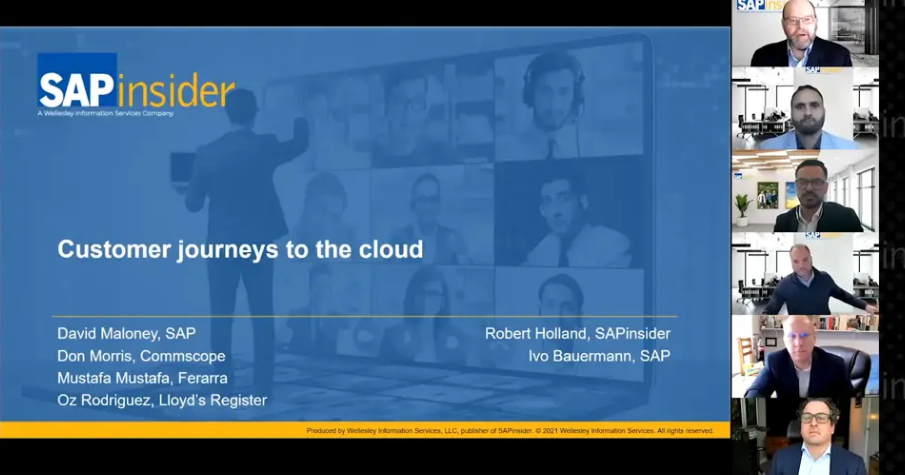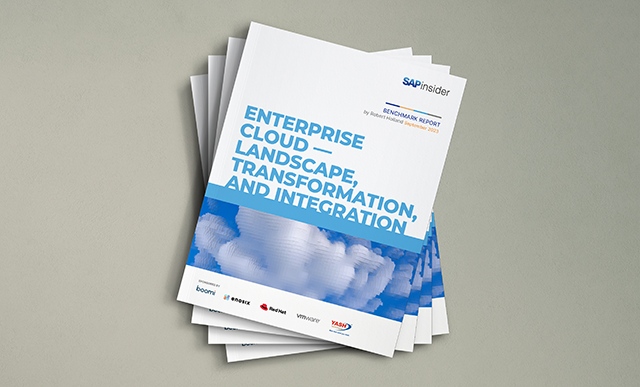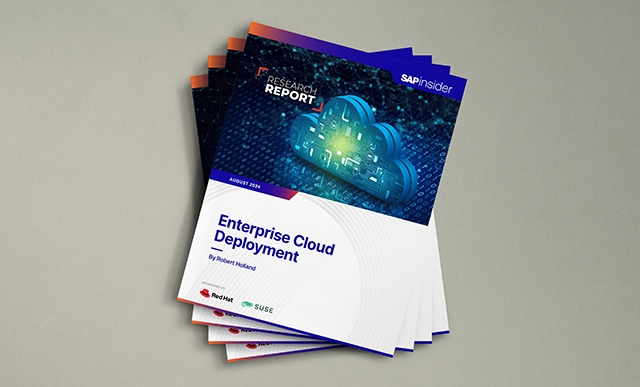A Robust Approach for Modernizing SAP with Microsoft Azure
Meet the Authors
Key Takeaways
⇨ Key Drivers for SAP on Azure
⇨ Key Challenges and Trends for Azure
⇨ Value-based Methodology to Remove Risks
Deploying SAP on the cloud is a major, risky, and expensive project for any organization that is embarking on the move. Skills and deep experience are critical to deciding on the deployment approaches and infrastructure choices, preparing existing systems and data, assigning a strong team of internal IT and business resources supplemented by partners, and then managing the project itself.
SAPInsider Vice President of Research, Deepa Salem, discussed this timely topic with Ajay Dhingra, Founder and President, and Ramya Nair, Director of ERP and Cloud solutions at Khoj Information Technology, a premium technology solutions provider that has been managing this transition of SAP to Microsoft Azure for several clients for many years.
Key Drivers for SAP on Azure
Microsoft Azure remains a popular provider of the cloud for SAP. According to SAPinsider research on Enterprise Cloud Deployment based on 187 respondents globally, over half (52%) of respondents are using or planning to use SAP Azure for their SAP workloads. The key reason cited was that digital transformation requires cloud-based deployments (34%). Pressure to modernize infrastructure to lower costs and simplify IT (33%) was nearly as important, and those were followed by a demand for newer technologies and best solutions available in the cloud (32%) and pressure to deploy solutions more quickly than on-premise infrastructure supports (27%).
Dhingra confirms this based on what Khoj sees in their customer base: “first when customers embark on their cloud journey, they are looking at digital transformation and infrastructure modernization. With hyper-scale cloud platforms like Azure, they look for scalability, high availability, security, flexibility, and agility.” This is a strategic factor that contributes most to the business case.
Dhingra adds, “second, customers often have impending data center lease renewal decisions. To avoid multiple disruptions to their business, customers are looking to accomplish both the SAP S/4HANA upgrade and their cloud migration together simultaneously in a single initiative. Third, some see migrating their disaster recovery workloads before their production workloads as a risk-averse way to get getting started with the cloud.”
Key Challenges and Trends for Azure
While there is a significant demand for SAP migration to Azure, considering the scale and expense of such a project, customers are being cautious. While the benefits are many, customers perceive challenges such as the risk of downtime, especially with business-critical SAP, concerns about migration integrity, availability, change management, and business user satisfaction.
To mitigate these risks, many customers are requesting customized assessments offered by experts such as Khoj to assess their cloud readiness and build a project roadmap. The assessments span people, processes, and technologies.
The technologies used to migrate an SAP workload to Azure are quite mature. However, customers want to choose providers who have experience with complex SAP and bolt-on application migrations. Dhingra confirms this: “It is very important to invest in certifications. Having both SAP and Azure certifications helps cross-train resources in both skills, which are critical for the complex implementations.”
As a partner in such projects, Dhingra adds, “Communication and knowledge management are equally important.”
Value-based Methodology to Remove Risks
From a process standpoint, Khoj offers a much sought-after method that spans assessment, migration, and operations. This CloudScape4SAP method forms the cornerstone of both their assessment and foundation work. It helps deliver value to customers with varying levels of size and complexity. Dhingra explains, “Cloud assessment and readiness component has a cloud base where we build the foundation and the scaffolding, and then migrate all build whether it is a brownfield or a greenfield implementation. In addition, we have a very specific operate and maintain approach across 25 plus service disciplines, ensuring that we can run a stable system.”
The CloudScape4SAP methodology has the following key components:
- CloudGauge and CloudBase help with as-is assessment and readiness review which helps to build the foundation. It helps the organization answer key questions such as which applications, databases and infrastructure make the most sense to migrate to Microsoft Azure. Pre-built questionnaires and focused workshops lead to the business case/cost analysis, readiness assessment, and a high-level migration path and plan.
- CloudShift and CloudErect handle both brownfield and greenfield migration and build of SAP on Azure. For brownfield migrations, it helps decide on the migration approach – rehost, replatform, repurchase, refactor, keep, or retire. For greenfield setups, it helps follow SAP Activate methodology.
- CloudRun and CloudBoost set up optimal operations, maintenance, and continuous improvement by focusing on operational readiness, performance, and cost optimization.
A combination of this repeatable process and certified resources deliver value and minimizes the risks. The optimization and quality of migration delivery, driven via Khoj CloudScape4SAP methodology, is what makes it so popular at Azure Marketplace. This is a key accelerator for a digital transformation.
Case Studies for Moving to Microsoft Azure – Campbell Soup Company
Companies deployed of SAP Azure for various reasons. Nair provided several success stories, each varying in their goals and approaches.
“For Campbell Soup Company, the driver was resiliency. They achieved about 90% reduction in archiving job runtime and 80% reduction in batch run times. Whereas, for Chobani, the popular yogurt brand, it was a vehicle to embark on its modernization journey to the cloud to support its booming IT landscape. For yet another customer, it was to create a simple, robust, scalable, and highly available architecture,” she explained.
Nuts and Bolts of the Methodology
Assessment is very key for SAP S/4HANA and cloud deployments. Understanding the as-is landscape and defining the to-be landscape is the first step toward success. So, Khoj recommends starting with both SAP S/4HANA assessment and cloud readiness assessment. In addition, Nair mentions that some customers even opt for technical architecture assessment because they want to evaluate their existing SAP workloads from a performance standpoint.
By the time a customer goes through these detailed assessments, they get answers to many important questions – what are risks, how can we ensure business continuity, what does the migration entail, what licensing approach should we take, what are cost differentials in cloud, how much time would it take, how would we move our landscapes, what are the integration challenges, how much are the time and cost budgets, etc. In addition, Nair adds, “It also includes the critical people factor. What is the involvement of different people needed? What are the expectations of business users?”
Expertise is Key to Success
Khoj, being an SAP silver services partner for over sixteen years and a Microsoft Gold partner for over seven years, has in-depth expertise in this critical intersection of SAP and Microsoft to enable such an in-depth assessment. The optimization and quality of migration delivery, driven via Khoj CloudScape4SAP method, is what makes it so popular at the Azure Marketplace. This is a key accelerator for digital transformation.
They can work with the sales teams at both SAP and Microsoft to bring forth such solutions. Based on the trends, more and more SAP customers are exploring and moving to the cloud either completely or as a hybrid deployment.
Nair adds, “The next few years are very critical years for the SAP community. Many customers are yet to make the journey to SAP S/4HANA and to Azure. We hope to play a very important part in helping customers make that journey less risky and leading to successful outcomes.”
What Does This Mean For SAPinsiders?
Our research reveals that SAP customers should apply the following key steps to their SAP deployments on the cloud:
- Embark on an in-depth assessment to understand as-is landscape, business requirements, and cost implications to make high-level decisions on approach. Also, understand what goals you want to achieve and how you measure that success. We list the most selected measures above, but others include improved security, increased automation, user experience, delivery of new capabilities, and more innovation.
- Evaluate cloud providers and deployment partners to see which will meet both your success criteria and provide other services that you can leverage. Depth in both SAP and the cloud provider, as well as a proven methodology that removes risk and delivers smooth migrations, is key.
- Cloud modernization is not a solo project. Continuous optimization and transformation are essential for achieving value. Business users will continue to demand performance and functionality. Continue to deploy a framework to run, optimize, and innovate as a discipline.
About Khoj Information Technology
Founded in 1998, Khoj Information Technology began with SAP technical architecture advisory services for Fortune 100 customers. Today Khoj’s strengths are–ERP Advisory, Integration Solutions and Services, Cloud security, ERP and Enterprise and Application Modernization on Cloud and Cloud Managed Services. We are focused on delivering a predictable, risk-free SAP/ERP/Enterprise digital transformation journey for our customers.
![]()






